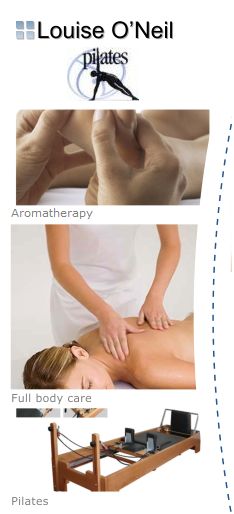Sports massage - Aromatherapy - Pilates Javea
Pilates Essentials, several instructional excercise videos
Personal health care Javea, reflexology and personal training.
Pilates instruction videos
These instructional videos for Pilates excercises were found on Youtube and may be slow loading or contain advertising.

Knowing how to take a full, deep breath is true life skill.
A full breath cycle spreads life-giving oxygen throughout the body, gets rid of waste gasses like carbon dioxide, and stimulates the spine and internal organs.
Deep breathing is an essential part of maximizing any form of exercise you do.
In Pilates, we use the dynamic of full breathing -- big inhales and exhales -- to initiate and power our Pilates exercises, and most Pilates exercises are taught with breathing patterns.
One of the first steps in learning to breathe well is to learn diaphragmatic deep breathing. The diaphragm is a dome-shaped muscle that sits below the lungs, horizontally bisecting the trunk of the body.
When you breath in, the diaphragm contracts and flattens downward creating a vacuum that draws in air. When you exhale, the diaphragm returns to its dome shape, pushing air out of the body.
Once you know how to get your diaphragm working for you, you will find that diaphragmatic breathing is both energizing and relaxing. It is the way a truly efficient body breathes throughout life.
Using diaphragmatic breathing consciously is a popular technique for stress reduction as well.
Pilates breathing exercises.
Try This Diaphragmatic Breathing Exercise:
- The Set Up: You can do this exercise lying on your back with your knees bent or even now, sitting up reading. Either way, do it with one hand resting lightly on your lower belly so you can feel your breath move your body.
- check points:
- Your shoulders relaxed and dropped away from your ears.
- Your spine is long, in what we call neutral spine, a natural position of the spine that allows the curves of the spine to be present.
- If you are sitting, feel that your weight is falling directly down through your sit bones and your head is floating up toward the sky.
- Your throat is open and relaxed.
- The Inhale: Breathe in slowly through your nose. Let the air flow into your upper chest and down your spine -- expanding the sides and lower ribs, filling the diaphragm, back and lower back, and dropping all the way down into the pelvis. Allow the deep inhale to push your belly out a little bit.
- The Exhale: Let go of your breath in the reverse order that you brought it in. Drop your lower abs, then your belly. Let your ribs pull in, and last, let your chest to drop as you fully expel all the air.
- Repeat: Do this diaphragmatic breathing exercise a few times until you get the sense of how each part flows into the next.
Tips:
- When you breathe in, try not to let it affect your shoulders. You want your shoulders to stay down and relaxed.
- Similarly, you want the inhale to be balanced all the way around the body. The chest does move with the breath but remains relaxed and the ribs maintain their cylindrical shape.
- Enjoy! Almost nothing serves us more than deep breathing.